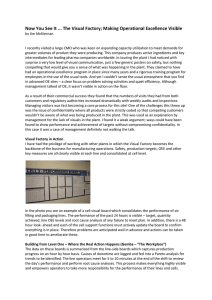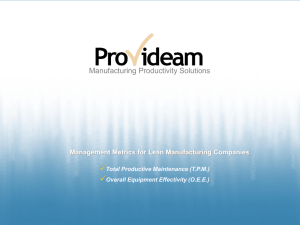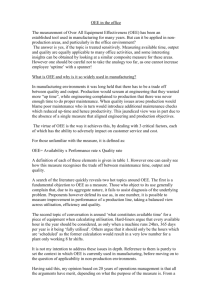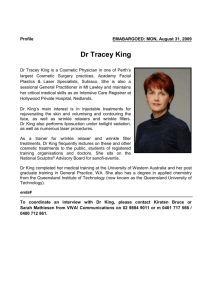Document 12913223
advertisement
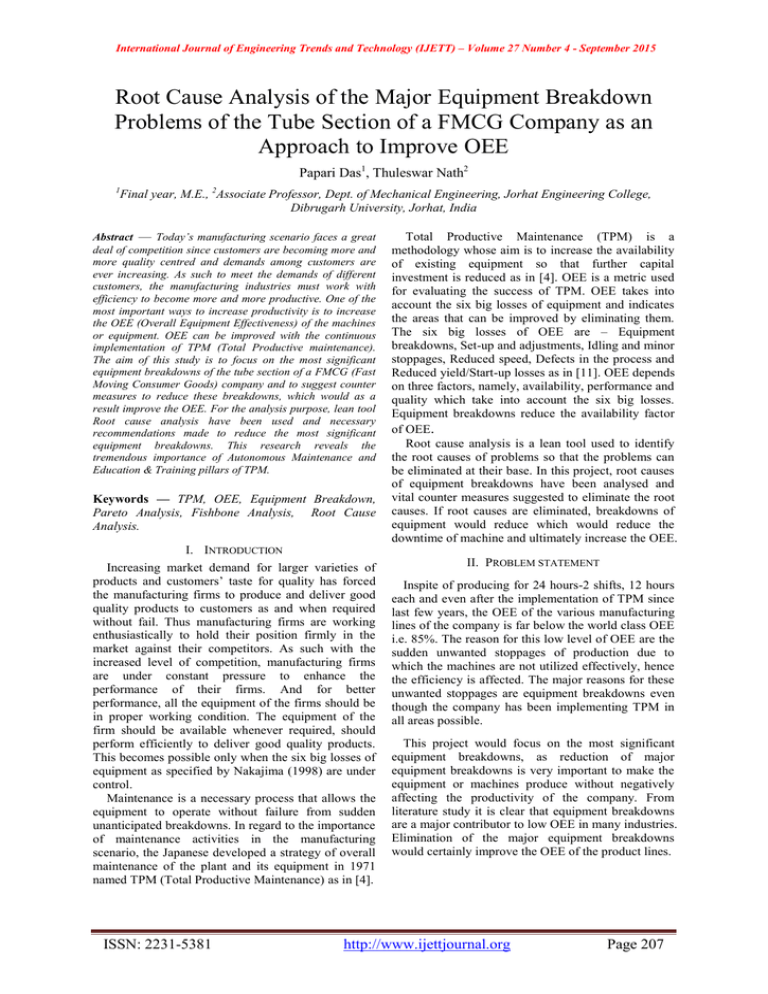
International Journal of Engineering Trends and Technology (IJETT) – Volume 27 Number 4 - September 2015 Root Cause Analysis of the Major Equipment Breakdown Problems of the Tube Section of a FMCG Company as an Approach to Improve OEE Papari Das1, Thuleswar Nath2 1 Final year, M.E., 2Associate Professor, Dept. of Mechanical Engineering, Jorhat Engineering College, Dibrugarh University, Jorhat, India Abstract — Today’s manufacturing scenario faces a great deal of competition since customers are becoming more and more quality centred and demands among customers are ever increasing. As such to meet the demands of different customers, the manufacturing industries must work with efficiency to become more and more productive. One of the most important ways to increase productivity is to increase the OEE (Overall Equipment Effectiveness) of the machines or equipment. OEE can be improved with the continuous implementation of TPM (Total Productive maintenance). The aim of this study is to focus on the most significant equipment breakdowns of the tube section of a FMCG (Fast Moving Consumer Goods) company and to suggest counter measures to reduce these breakdowns, which would as a result improve the OEE. For the analysis purpose, lean tool Root cause analysis have been used and necessary recommendations made to reduce the most significant equipment breakdowns. This research reveals the tremendous importance of Autonomous Maintenance and Education & Training pillars of TPM. Keywords — TPM, OEE, Equipment Breakdown, Pareto Analysis, Fishbone Analysis, Root Cause Analysis. I. INTRODUCTION Increasing market demand for larger varieties of products and customers’ taste for quality has forced the manufacturing firms to produce and deliver good quality products to customers as and when required without fail. Thus manufacturing firms are working enthusiastically to hold their position firmly in the market against their competitors. As such with the increased level of competition, manufacturing firms are under constant pressure to enhance the performance of their firms. And for better performance, all the equipment of the firms should be in proper working condition. The equipment of the firm should be available whenever required, should perform efficiently to deliver good quality products. This becomes possible only when the six big losses of equipment as specified by Nakajima (1998) are under control. Maintenance is a necessary process that allows the equipment to operate without failure from sudden unanticipated breakdowns. In regard to the importance of maintenance activities in the manufacturing scenario, the Japanese developed a strategy of overall maintenance of the plant and its equipment in 1971 named TPM (Total Productive Maintenance) as in [4]. ISSN: 2231-5381 Total Productive Maintenance (TPM) is a methodology whose aim is to increase the availability of existing equipment so that further capital investment is reduced as in [4]. OEE is a metric used for evaluating the success of TPM. OEE takes into account the six big losses of equipment and indicates the areas that can be improved by eliminating them. The six big losses of OEE are – Equipment breakdowns, Set-up and adjustments, Idling and minor stoppages, Reduced speed, Defects in the process and Reduced yield/Start-up losses as in [11]. OEE depends on three factors, namely, availability, performance and quality which take into account the six big losses. Equipment breakdowns reduce the availability factor of OEE. Root cause analysis is a lean tool used to identify the root causes of problems so that the problems can be eliminated at their base. In this project, root causes of equipment breakdowns have been analysed and vital counter measures suggested to eliminate the root causes. If root causes are eliminated, breakdowns of equipment would reduce which would reduce the downtime of machine and ultimately increase the OEE. II. PROBLEM STATEMENT Inspite of producing for 24 hours-2 shifts, 12 hours each and even after the implementation of TPM since last few years, the OEE of the various manufacturing lines of the company is far below the world class OEE i.e. 85%. The reason for this low level of OEE are the sudden unwanted stoppages of production due to which the machines are not utilized effectively, hence the efficiency is affected. The major reasons for these unwanted stoppages are equipment breakdowns even though the company has been implementing TPM in all areas possible. This project would focus on the most significant equipment breakdowns, as reduction of major equipment breakdowns is very important to make the equipment or machines produce without negatively affecting the productivity of the company. From literature study it is clear that equipment breakdowns are a major contributor to low OEE in many industries. Elimination of the major equipment breakdowns would certainly improve the OEE of the product lines. http://www.ijettjournal.org Page 207 International Journal of Engineering Trends and Technology (IJETT) – Volume 27 Number 4 - September 2015 III. OBJECTIVE OF THE STUDY Improvement of OEE of tube section of a FMCG company by1. Identifying the root causes of major equipment breakdowns. 2. Suggesting counter measures to reduce or eliminate the root causes identified so as to reduce equipment breakdowns. IV. CASE STUDY This case study has been conducted in one of the most important FMCG (fast moving consumer goods) company located in Guwahati, Assam. The company has ISO 9001-2008, 14001 certification and products made by the company are different types of cosmetics that have a huge demand in the market in and outside India. The study will be carried out in the tube section as because it is the section with the lowest OEE among all sections and production is interrupted very often in this section due to equipment breakdowns. There are total of nine product lines in the tube section and two product lines with the lowest OEE has been considered for the study and necessary suggestions have been recommended to eliminate the major reasons of equipment breakdowns. The study has been conducted for four months through constant reviewing on the shop floor, studying and understanding the machines under study, interviewing and brainstorming maintenance personnel and operators about the unwanted equipment stoppages. V. RESEARCH METHODOLOGY A. OEE data collection The OEE data of the 9 product lines of the tube section have been collected for a period of six months (01/08/14 to 31/01/15) from the web portal of the company. Among the 9 product lines, 2 product lines having 4 machines, 2 machines per product line i.e 1 fillng machine and 1 packing machine having the lowest OEE have been selected for the analysis purpose of equipment breakdowns. As seen from the OEE data analysis, ―WIMCO4+VP‖ and ―PACMAC-6+HICART‖ machines had the lowest average OEE and hence these two product lines were taken up for the analysis purpose. WIMCO4, PACMAC-6 are the filling machines. HICART, VP are the packing machines. B. Analyses of equipment breakdown reasons Equipment breakdown, a downtime loss is the sudden unwanted stoppage of the equipment due to failure or improper working of some parts of the equipment, in most cases due to improper maintenance of the equipment. The various problems contributing to equipment breakdowns were reviewed from the log-sheets for a period of same six months as the OEE data collection ISSN: 2231-5381 period. Thereafter, Pareto were plotted to identify the reasons contributing to 80% of the breakdown time of the equipment. As seen from Fig. 1, wrinkle problem, offcentre problem, filling problem, electrical problem and sealing problem constitute almost 80% of the total maintenance time for all the breakdown problems for WIMCO-4 machine. As seen from Fig. 2, timing out, willet or coding problem and SPC timing out problem constitute 85.9% of the total maintenance time for all the breakdown problems for VP machine. As seen from Fig. 3, offcentre problem, sealing problem, wrinkle problem, heater problem, batch number coding box problem and conveyor problem constitute 82.1% of the total maintenance time for all the breakdown problems for PACMAC-6 machine. As seen from Fig. 4, coding problem, autocollator problem, timing out problem, linkup problem, carton chain timing out problem, drum & landing problem and closing setting problem constitute 80.9% of the total maintenance time for all the breakdown problems for HICART machine. 1) Root Cause Analysis: After identifying the major problems of equipment breakdown from the Pareto analyses, fishbone diagrams or Ishikawa diagrams were drawn for all the problems of equipment breakdown that accounts for 80% of the total maintenance time, for all the four machines under study to determine the root causes of the major problems, by conducting thorough interviews and brainstorming sessions with operators, maintenance personnel and experts from the company. Fishbone diagram is one of the seven basic Quality Control tools used for identifying the root causes of problems. In this project, Fishbone diagrams have been constructed mostly based on the categories of man, machine, method and material. After identification of the root causes, vital recommendations are made to eliminate the root causes. VI. RESULTS AND RECOMMENDATIONS After the root causes for various equipment breakdowns were identified and analysed, counter measure plans of breakdowns of the selected machines is constructed as shown in tables I, II, III, IV, V, VI, where counter measures are suggested to eliminate or reduce the root causes. The counter measure plans for the two filling machines have been shown in tables I, II, III and the counter measure plans for the two packing machines have been shown in tables IV, V, VI. The format of the counter measure tables has been formed in partial reference to [4]. The counter measure plans for the the two filling machines (WIMCO-4 and PACMAC-6) have been suggested in the same tables (table I, II, III) as because the root causes of breakdowns of these two machines are identical. Similar is the case with the two packing http://www.ijettjournal.org Page 208 International Journal of Engineering Trends and Technology (IJETT) – Volume 27 Number 4 - September 2015 machines (HICART and VP) whose counter measure plans are shown in tables IV, V, VI. A. Results From tables I, II, III, it is seen that 46% of the total root causes occurs due to improper CLIT (cleaning, inspection, lubrication, tightening) which is the most important phase of Autonomous Maintenance, 30% of total root causes occurs as a result of lack of training of operators, supplier problem accounts for 9.3% of the total root causes, another 9.3% of the total root causes occurs due to failure of some parts that are unavoidable and for the rest 4.6 % of the total root causes Kaizens have been suggested to eliminate them. From tables IV, V, VI, it is seen that 55.55% of the total root causes occurs due to improper CLIT of packing machines under study, 19% of the total root causes occurs due to lack of training of operators, supplier problem accounts for 16% of the total root causes and the rest 8.3% of the total root causes needs direct replacement when failed. VII. CONCLUSIONS As seen from the analysis Jishu Hozen (JH) or autonomous maintenance is a very important TPM pillar that keeps the equipment in a reliable condition and prevents forced deterioration of the equipment. Hence JH is a must to prevent the equipment from breaking down which would in turn increase the OEE of the equipment. Training should be imparted to the operators for proper handling of the equipment and to take up JH in a more serious manner. Proper JH would uplift the condition of the equipment. REFERENCES [1] [2] [3] B. Recommendations The root cause analysis suggests that majority of root causes of equipment breakdown of the selected machines occurs due to poor Autonomous Maintenance (Jishu Hozen) of the equipment and due to lack of training of the operators as discussed in the results section. Hence following recommendations are made1. Operators should be informed about the tremendous importance of Autonomous Maintenance to keep their equipment in proper working condition. It is seen from shop floor visits that almost all operators tend to neglect the JH activities even though there are JH (Jishu Hozen) plans in the company and maintenance activities take place only when the equipment malfunctions. Hence it is of utmost importance to let the operators know about the benefits of Jishu Hozen pillar of TPM to reduce the downtime of machines due to equipment breakdowns. 2. Training and Education should be imparted to operators on a regular basis for proper handling of the equipment which would reduce the downtime due to improper setting of various parts of the equipment. The root causes identified, problems caused by the root causes, reasons of the root causes, counter measurement plans, necessary Kaizens, time necessary for JH activities and method of JH activities are suggested in table (I, II, III, IV, V, VI) for the selected machines which will provide good benefit to the company if implemented. The counter measures, Kaizens, method and time of JH are suggested after interviewing and discussing with the operators, maintenance personnel and TPM group members from the company. ISSN: 2231-5381 [4] [5] [6] [7] [8] [9] [10] [11] Kiran M, Cijo Mathew, Jacob Kuriakose, ―Root cause analysis for reducing breakdowns in a manufacturing industry‖, International Journal of Emerging Technology and Advanced Engineering, Volume 3, Issue 1, January 2013. Ranteshwar Singh, Ashish M Gohil, Dhaval B Shah, Sanjay Desai, ―Total Productive Maintenance (TPM) Implementation in a Machine Shop: A Case Study‖, Procedia Engineering 51 (2013) 592-599. S.R.Vijayakumar, S.Gajendran, ―IMPROVEMENT OF OVERALL EQUIPMENT EFFECTIVENESS (OEE) IN INJECTION MOULDING PROCESS INDUSTRY‖, IOSR Journal of Mechanical and Civil Engineering (IOSR-JMCE), e- ISSN: 2278-1684, p-ISSN : 2320–334X, PP 47-60 Amit Kumar Gupta, Dr. R. K. Garg, ―OEE Improvement by TPM Implementation: A Case Study‖, International Journal of IT, Engineering and Applied Sciences Research (IJIEASR), Volume 1, No. 1, October 2012. Chowdury M. L. Rahman, M. A. Hoque, Syed Misbah Uddin, ―Assessment of Total Productive Maintenance Implementation through Downtime and Mean Downtime Analysis (Case study: a Semi-automated Manufacturing Company of Bangladesh)‖, IOSR Journal of Engineering (IOSRJEN), Vol. 04, Issue 09 (September. 2014), ǀ ǀ V4ǀ ǀ PP 38-47. Prof Pradeep Kumar, Dr. K.V.M. Varambally, Dr. Lewlyn L.R. Rodrigues, ―A Methodology for Implementing Total Productive Maintenance in Manufacturing Industries–A Case Study‖, International Journal of Engineering Research and Development, Volume 5, Issue 2 (December 2012), PP. 32-39. Osama Taisir R.Almeanazel, ―Total Productive Maintenance Review and Overall Equipment Effectiveness Measurement‖, Jordan Journal of Mechanical and Industrial Engineering, Volume 4, Number 4, September 2010, ISSN 1995-6665, Pages 517 – 522. Disha M Nayak, Vijaya Kumar M N, G.Sreenivasulu Naidu, Veena Shankar, ―Evaluation Of Oee In A Continuous Process Industry On An Insulation Line In A Cable Manufacturing Unit‖, International Journal of Innovative Research in Science, Engineering and Technology, Vol. 2, Issue 5, May 2013. Hemant Singh Rajput, Pratesh Jayaswal, ―A Total Productive Maintenance (TPM) ApproachTo Improve Overall Equipment Efficiency‖, International Journal of Modern Engineering Research (IJMER), Vol.2, Issue.6, NovDec. 2012 pp-4383-4386. Sarang G. Katkamwar, Sadashiv K. Wadatkar, Ravikant V. Paropate, ―Study of Total Productive Maintenance & Its Implementing Approach in Spinning Industries‖, International Journal of Engineering Trends and Technology (IJETT) - Volume4Issue5- May 2013 Prof. A.Bangar, Hemlata Sahu, Jagmohan Batham, ―Improving Overall Equipment Effectiveness by Implementing Total Productive Maintenance in Auto Industry‖, International Journal of Emerging Technology and Advanced Engineering, Volume 3, Issue 6, June 2013. http://www.ijettjournal.org Page 209 International Journal of Engineering Trends and Technology (IJETT) – Volume 27 Number 4 - September 2015 [12] Ponce-Hernández M.M., González-Angeles A, NavarroGonzález C.R. and Cabrera-Córdova E., ―Overall Equipment Effectiveness (OEE) Diagnosis and Improving in a Small Business as an Essential tool for Business Competitiveness‖, Research Journal of Recent Sciences, Vol. 2(6), 58-65, June (2013). Fig. 1 Pareto Analysis of equipment breakdown problems of WIMCO-4 machine Fig.2 Pareto Analysis of equipment breakdown problems of VP machine ISSN: 2231-5381 http://www.ijettjournal.org Page 210 International Journal of Engineering Trends and Technology (IJETT) – Volume 27 Number 4 - September 2015 Fig. 3 Pareto Analysis of equipment breakdown problems of PACMAC-6 machine Fig. 4 Pareto Analysis of equipment breakdown problems of HICART machine ISSN: 2231-5381 http://www.ijettjournal.org Page 211 International Journal of Engineering Trends and Technology (IJETT) – Volume 27 Number 4 - September 2015 TABLE I COUNTER MEASURE PLAN FOR POOR AUTONOMOUS MAINTENANCE OF WIMCO-4 and PACMAC-6 Category method electrical Root causes identified from Fishbone Analysis Problems caused by the root causes Reason for the root causes Recommended Counter measurement plan Time M ethod of suggested Recommended CLIT for CLIT Kaizens (mins) jacket water pipe line jam wrinkle, sealing untimely cleaning daily cleaning pressurized air wrinkle untimely cleaning monthly cleaning diesel, dry cloth 45 untimely cleaning untimely cleaning monthly cleaning pressurized air 5 dirty particles in blower fan improper filtering of air by air filter dust, cream in sensor face holder gripper spring wear out connector of cylinder and air pipe damaged machine machine sealing untimely inspection untimely inspection dry cloth 2 weekly inspection visual 5 daily inspection 10 10 untimely inspection monthly inspection visual cut up damage wrinkle, sealing untimely inspection & cleaning weekly inspection & cleaning visual,dry cloth 10 sealer shaft bushing loose due to wear and tear wrinkle, sealing oil 5 sealer bushing wear and tear batch number coding box untimely lubrication weekly lubrication grease 5 oil 2 sealer bushing loose loose bolt in stepper motor pulley connector of controller and stepper motor loose loose connection of lifting cam magnet head loosens out of lifting rod thread 2 mallet hammer 20 offcentre alen key 2 offcentre manual 5 alen key 10 manual 3 offcentre improper handling of controller bent tube stuck in heater improper cut-up setting improper setting of photocell loose alen key bolt of coding box improper adjustment of sensor Category Root causes identified from Fishbone Analysis bent, oval tube eye mark height problem cap loose connector of cylinder and air pipe becomes loose sealing spanner 5 heater contactor loose electrical, heater manual 8 offcentre wrinkle, sealing, batch no coding box electrical Problems caused by the root causes wrinkle, offcentre offcentre Reason for the root causes Recommended Counter measurement plan Recommended Kaizens packing material of bad quality change purchased supplier/vendor sealing, coding digits batch no out of coding box specification offcentre machine improper length of batch no coding digits metal sensor damage offcentre machine photocell sensor damage failed parts that cannot be repaired method blower bearing wear out offcentre offcentre, electrical wrinkle machine cap,tube etc present in rework cream that block the holes in hopper,wall and nozzle wrinkle, filling, sealing repeated use of same filter cloth for a long time a) Use of good quality filter cloth b)change filter cloth after filtering 10 drums machine IC mother board damage due to overheat in electrical panel filling absence of cooling fans though there are provisions for it Installation of cooling fans controller card damage ISSN: 2231-5381 offcentre TABLE III COUNTER MEASURE PLAN FOR OTHER BREAKDOWN ROOT CAUSES FOR WIMCO-4 and PACMAC-6 material offcentre Training and Educationoperators not monthly training wrinkle, sealing properly to operators on wrinkle, sealing trained machine wrinkle, filling, operation sealing wrinkle improper O-ring dia of piston electrical Recommended Counter measurement plan wrinkle, sealing, heater wrinkle, electrical, heater wrinkle, electrical, heater improper setting of wrinkle guard machine Reason for the root causes any problem being analysed cable inside stepper motor wire tear out due to mishandling plier monthly tightening use of metal connectors in place of rubber connectors 15 wrinkle, electrical, heater wrinkle, sealing irregular tightening of machine parts new operator unskilled operator wrong type of thermocouple visual Problems caused by the root causes Root causes identified from Fishbone Analysis improper rotometer setting wrinkle, filling, sealing filling Category man wear and tear of piston O-ring rack teeth damage electrical wrinkle 5 daily cleaning untimely daily improper knurling in batch number visual,copper inspection & inspection and coding box coding brush cleaning cleaning loose thermocouple connection machine electrical offcentre, electrical TABLE II COUNTER MEASURE PLAN FOR IMPROPER TRAINING TO OPERATORS OF WIMCO-4 and PACMAC-6 http://www.ijettjournal.org direct replacement Page 212 International Journal of Engineering Trends and Technology (IJETT) – Volume 27 Number 4 - September 2015 TABLE IV COUNTER MEASURE PLAN FOR POOR AUTONOMOUS MAINTENANCE OF HICART and VP Category Root causes identified from Fishbone Analysis machine untimely cleaning of vacuum filter Problems caused SPC landing, timing out Recommended Reason for root Counter causes measurement plan untimely cleaning weekly cleaning M ethod of CLIT pressurized air Time suggested Recommended for CLIT Kaizens (mins) man dust and oil accumulation on method vacuum plates SPC landing, timing out dust and oil accumulation on motor shaft bearing bevel gear shaft worn machine closing setting out connector damage autocollator new operator bad adjustment of sensor untimely cleaning monthly cleaning dry cloth untimely cleaning weekly cleaning dry cloth untimely inspection daily inspection weekly lubrication improper setting of LM L visual ISSN: 2231-5381 10 grease 2 grease 30 daily tightening spanner 2 weekly tightening alen key 2 daily visual, inspection and spanner/alen tightening key daily visual, loose bolt in drum inspection and spanner/alen drum, SPC tightening key landing, timing weekly visual, out machine loose chain of drum inspection and spanner/alen tightening key weekly loose bearing in mallet inspection and untimely pusher hammer tightening inspection and weekly tightening of loose bolt of pusher alen key machine parts inspection and guard tightening timing out monthly loose bolt of cams inspection and alen key tightening loose bolt in sprocket monthly due to improper inspection and alen key maintenance tightening daily loose connector of method autocollator inspection and spanner cylinder and air pipe tightening SPC landing, timing out 30 5 machine use of metal connectors in place of rubber connectors Recommended Counter measurement plan any problem being analysed unskilled operator bearing breakage in untimely closing setting closing assembly lubrication bearing of drum wear machine drum, SPC out landing, timing no lubrication gear of drum wear out out loose connection of coding sensor untimely loose bolt in gear of tightening of closing assembly closing setting machine parts loose bolt in closing cam loose nut and bolt of suqr chain Category Problems caused Reason for by the root root causes causes Root causes identified from Fishbone Analysis 30 vacuum filter jam method TABLE V COUNTER MEASURE PLAN FOR IMPROPER TRAINING TO OPERATORS OF HICART and VP improper shutdown of coding machine improper setting of tuckin -assembly improper setting of drum SPC coding closing setting operators not properly trained Training and Educationmonthly training to operators on machine operation drum, SPC landing, timing out TABLE VI COUNTER MEASURE PLAN FOR OTHER BREAKDOWN ROOT CAUSES FOR HICART and VP 2 5 Category Problems `Root causes identified from Reason for caused by the Fishbone Analysis root causes root causes machine solenoid valve jam due to bad particles in ink ink filter getting jammed due to bad particles in ink solenoid valve damaged due to bad quality of make-up L-valve damaged due to bad quality of make-up 5 5 10 10 15 method gum in SPC, hard SPC SPC coding ink and make-up of bad quality dust in SPC autocollator machine sealing tape damage of autocollator wear and tear of cutting blade failed parts that cannot be repaired untimely change of ink filter SPC coding prolonged use of same ink filter 2 http://www.ijettjournal.org Recommended Kaizens change supplier/vendor closing setting, packing SPC landing, material of timing out bad quality machine 3 Recommended Counter measurement plan direct replacement Page 213 install new ink filter in every 3 months

